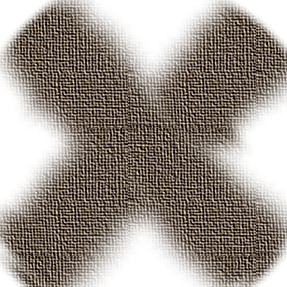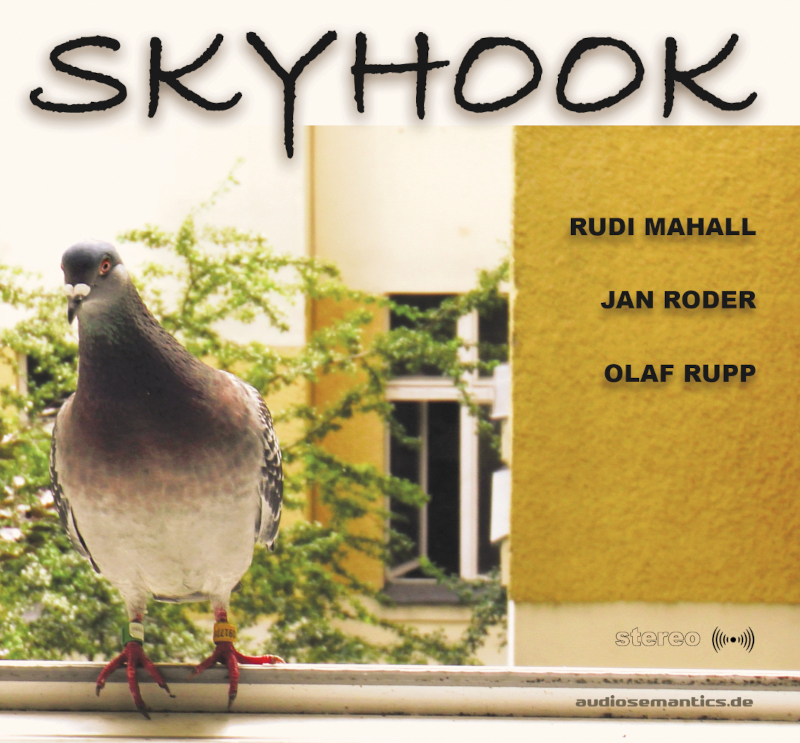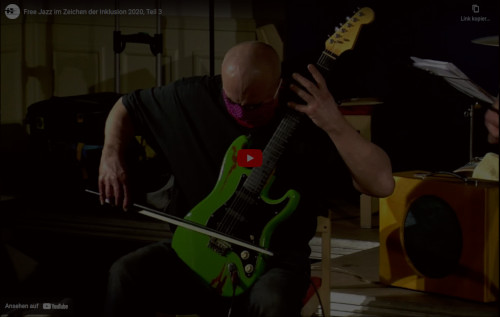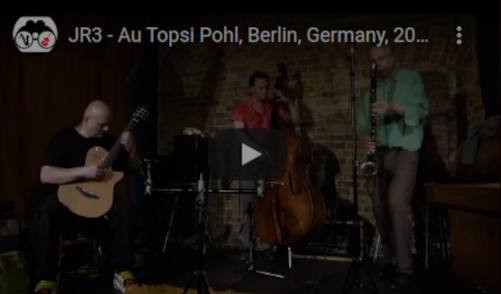JR3
Mahall Rupp Roder
JR3
Mahall Rupp Roder

the Band:
In the early 2000s the all members of JR3 lived near the same park in Berlin and were able to meet and improvise happy chamber music without drums (...aah) in their living rooms. As a result of these sessions JR3 was awarded a 'studio award' from the Berlin Senate, through which the first recordings became available to a small circle of insiders.Through the years, JR3 played many happy concerts over and over again, eventually also gaining the attention of the New Yorker label 'relative pitch'. At last, the new CD 'Happy Jazz' is available for your enjoyment.
Fundamental to their music in their view, is the interconnected spontaneity, and that virtuosity and simplicity, as well as the strict and the flippant are placed in direct and peaceful proximity to one another. Like a societal concept, these poles are allowed to coexist and to combine as a collage. Yet they are also able to come together with surprising speed and precision.
Kontakt: info[at]janroder.de

die Band
JR3 wohnten in den frühen 2000er Jahren am selben Park in Berlin und konnten sich ohne Schlagzeug… aah… wunderbar zu Hause treffen und fröhliche Kammermusik miteinander improvisieren.. Gleich darauf gab es den Studiopreis des berliner Senats, wodurch die ersten, einem nur sehr auserwählten Kreis zur Verfügung gestellten, Aufnahmen zustande kamen.. Über die Jahre spielten JR3 immer wieder fröhliche Konzerte und erregten so unter anderem auch die Aufmerksamkeit des New Yorker Labels ‚relative pitch‘ auf dem nun die CD ‚Happy Jazz‘ erschienen ist.Wesentlich an ihrer Musik ist erscheint ihnen die vernetzte Spontanität und dass sie virtuoses und simples, strenges und flapsiges wie einen gesellschaftlichen Entwurf friedlich nebeneinanderstellen, koexistieren lassen und kollagieren und dass sie dann aber trotzdem immer wieder auch überaschend schnell auch wieder präzise zusammenfinden.
the Musicians:
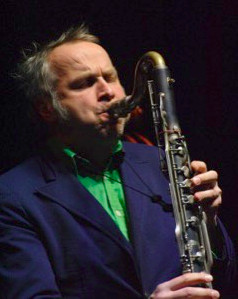
Rudi Mahall (born 1966 in Nürnberg, Germany) is a contemporary jazz bass clarinetist. While studying classical clarinet, Mahall shifted towards contemporary music, improvisation and jazz. He is, or was a member of following bands: Avantgardeband Die Hartmann 8, Der Rote Bereich (initially with Frank Möbus, Marty Cook, Jim Black und Henning Sievert), the Trio Tiefe töne für Augen und Ohren (with Sievert and Bill Elgart), Carlos Bicas Azul and Die Enttäuschung (amongst others with Axel Dörner, Jan Roder). He carried out several projects and published CDs with Aki Takase, about the work of Eric Dolphy and others. Mahall participated to Alexander von Schlippenbachs recording of the complete works of Thelonious Monk, published by a prestigious Swiss label, and he is a member of the Globe Unity Orchestra. Moreover he performed with Conny Bauer, Lee Konitz, Barry Guy, Karl Berger, Paul Lovens, Sven-Åke Johansson, Radu Malfatti, Ed Schuller, Ray Anderson, Kenny Wheeler, Hannes Bauer and many others. Mahall performed at the Free Music Festival Jazz a Mulhouse in 2008, at the Moers Festival, the JazzFest Berlin, the Leverkusener Jazztage and jazz festivals in New York City, Amsterdam, München, Würzburg, Nürnberg, Spain, Norway, France, etc and toured in Portugal, southern and eastern Africa.
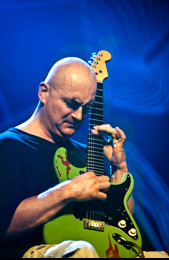
Olaf Rupp, (*1963) plays Improvised Music on the acoustic and electric guitar. The organic flow of his music is guided neither by chance nor by dominant, willful decisions. To him the same level of focus and attentive energy should be present in loud and fast music as well as in softer, more subdued kind of playing. In all his music he explores how motion-clusters can be perceived as one agglomerated sound in motion. This means that every note is a dot in a higher matrix and its color is more important than the position of that note in any hierarchic classification system. So a sequence of notes creates a moving sound, not a melody. And the intrinsic color of every note is more important than the melodic or harmonic burden which the listener may or may not put on it. Besides many cooperations five solo albums are published so far on the labels FMP, RELATIVE PITCH, GROB and GLIGG. Olaf Rupp has been touring in many countries and performed with extraordinary musicians such as Paul Lovens, Tristan Honsinger, Peter Brötzmann, Butch Morris, Lol Coxhill, John Zorn und Tony Buck. He is an outstanding solo performer both on electric and acoustic guitar. Important groups are among others XENOFOX, his duo with Rudi Fischerlehner, a Duo with cello player Ulrike Brand, and WEIRD WEAPONS with Tony Buck and Joe Williamson. www.audiosemantics.de
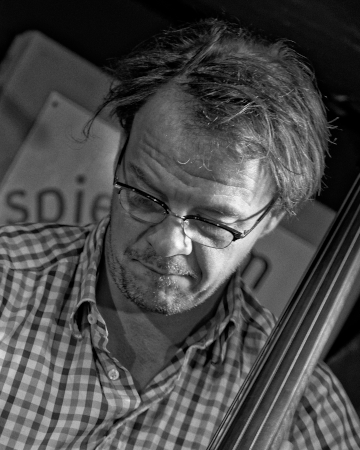
Jan Roder, born 1968 in Lübeck, Germany, plays bass and electric bass. He moved to Berlin in 1995 where he encountered musicians the likes of Dörner, Mahall, and v. Schlippenbach with whom he has played until today. Roder considers his musical 'home' to be post-free jazz and improvised music deeply rooted in the jazz tradition.
He collaborates with musicians such as Aki Takase, Gunter Hampel, Irene Schweizer, Ulrich Gumpert, Ernst Ludwig Petrowski, Thomas Borgmann, Peter Brötzmann, WolfgangPuschnig, Axel Dörner, Wlli Kellers, Michael Griener, Oliver Steidle, Silke Eberhard, Christof Thewes, Matthias Schubert, Olaf Rupp.....
and in projects such as Monks Casino, Die Enttäuschung, Soko Steidle, Squakk, Derek plays Eric (on electric bass), Silke Eberhard Trio, Ulrich Gumpert Quartett and Workshop Band, he played concerts and festivals on some continents and also works as a soloist and from time to time as a studio musician.
Foto: Alexander Schaffer
the CDs:
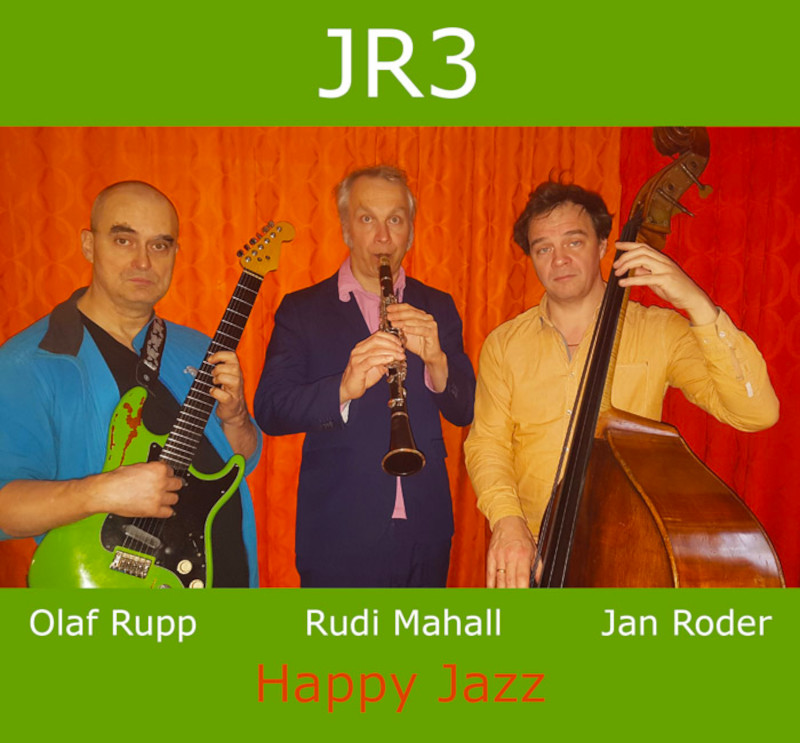

reviews:
SKYHOOK
Jazzword
German trio Skyhook (Audiosemantics 21002) consisting of bass clarinetist Rudi Mahall, bassist Jan Roder and guitarist
Olaf Rupp are confident enough of their individual skills that they cheerfully improvise in this unique configuration.
With peerless rhythmic command the bassist guides linear connection from the bottom with intermittent but steady strokes.
The clarinetist sounds a collection of split tones in chalumeau or clarion registers to advance or deconstruct the tunes.
Meanwhile the guitarist’s strums and stops bridge potential divisive intervals by capricious adjustments from foreground to
background textures; from high-pitched to low-pitched tones; and by frequently using harsh string chops to add extra percussion
to comprehensive melody affirmations. Skyhook was recorded live so that every contrapuntal challenge suggested by slurred
fingering and crying reed slurs at one point, or constant strumming facing clarion reed peeps at another, must be resolved
in real time before the program can proceed. Yet this doesn’t faze the three who in different combinations have a history of
involvement in all manner of advanced sounds. Should Roder for instance, cut off his connective rumble for squealing sul
ponticello slices as on “Vernünftig”, then Rupp’s potent strumming take on that comping role, muting Mahall’s reed barks and bites.
Or if the clarinetist completes his exposition with unbroken glissandi as on the concluding “Was Nicht Existiert”, then
the guitarist’s finger picking adds to the linear narrative. With the ability to incorporate into logical motion every extended
technique from bony string flanges or resonating twangs plus altissimo clarinet screeches or body-tube exhumed renal honks,
Skyhook is like an arial act that never has to rely on the waiting net. And if you listen closely, especially on tracks like
“Durch” and “Existiert” you may even hear snatches of swing plus perhaps a song quote that buttresses the sound deconstruction and exploration.
JAZZWORD, Ken Waxman
Freistil
JR 3 bringt den Kontrabassisten Jan Roder mit dem Klarinettisten Rudi Mahall und dem wahrlich einzigartigen
Gitarrenstilisten Olaf Rupp zusammen. Skyhook ist der zweite Tonträger dieses illustren Trios, wudre im Juli 2021 in
Berlin live aufgenommen und präsentiert zwölf aufregende Improvisationen. Der aus Daniel Defoes Robinson Crusoe stammende
Satz „Es ist ebenso vernünftig, eine Art von Gefangenschaft durch eine andere darzustellen, wie irgendetwas, was
wirklich existiert, durch etwas, was nicht existiert", der auch schon Camus' Pest den Epigraphen machte, gibt, in
Bruchstücke aufgesplittet, diesen Nummern ihre Namen. Die Musik ist dicht, intensiv, immer wieder überraschende Haken
schlagend. Reichhaltig in der Textur, ist, zumal über Mahalls Klarinetten, auch das Melodische beträchtlich, vom
Kürzelhaften hin bis zu längereren Linien. Die Interaktion ist Spitzenklasse. Man wandert auch durchaus weitschweifiger
voneinander ab, findet aber doch auch immer wieder eng zusammen und bewegt sich gemeinsam in schlafwandlerischer
Sicherheit durch vielfältige Klanglandschaften, agiert so sensibel wie auch kraft- und temperamentvoll.
Dies ist gemeinsame Aktion aus dem Moment heraus, von außerordentlicher Qualität, die sich zudem einer wirklich sehr
weiten Palette an musikalischen Materialien und Sounds bedient, wenn auch energische Dissonanzen weitgehend regieren.
FREISTIL, (bertl)
The Free Jazz Collective
It’s no secret that I’m a fan of Olaf Rupp’s music. His way of playing guitar (acoustic and electric), how he combines Flamenco, alternative rock and free jazz is simply unique. So, it’s no wonder that I was excited when I heard that he was going to release Skyhook, the second album of his outfit with bassist Jan Roder and clarinetist Rudi Mahall. The first one, JR3, was also well reviewed on our site.
Skyhook is in no way inferior to the trio’s debut, the music is a hodgepodge of stylistic elements that seem to be completely contradictory, but in the end they fit together very well. A perfect example of the trio’s music is the second track, “vernünftig“. It begins with Rupp’s guitar trills colliding with the emotional ebb and flow of bowed bass notes that seem to stream directly from Roder’s instrument, while Mahall intersperses his contributions very economically. When Roder puts away the bow and begins to pluck, the dynamics change. The bass sounds tumble, Rupp explodes as if Cecil Taylor was playing guitar and Mahall murmurs in the depths of his instrument, he groans, but also dares to make longer runs and sprinkles in a melody here and there. The whole thing is a zigzag run, you never know where it will go.
Skyhook consists of twelve tracks, the titles are cut up from the sentence Es ist ebenso vernünftig, eine Art Gefangenschaft durch eine andere darzustellen, wie irgendetwas, was wirklich existiert, durch etwas, was nicht existiert (It is as reasonable to represent one kind of captivity by another as it is to represent anything that really exists by something that does not). Albert Camus had borrowed it as the epigraph for his novel The Plague, it’s actually from Daniel Defoe’s Robinson Crusoe. Oran, the city on the Algerian coast where Camus’s novel is set, soon becomes an island, an isolated space - like Robinson’s island. Apart from the fact that the music becomes a metaphor for what’s going on around us there is a also another connection: The album was recorded at Au Topsi Pohl, a venue of the Echtzeit network in Berlin, which unfortunately is soon closing down but which was itself has been an island for free improvisation.
The title of the album refers to a figure from freestyle snowboarding. Rupp says that it somehow makes sense because making music is often a kind of throwing stones into the sky. And it symbolizes optimism. And even if he mentioned that as to his standards the recording was not quite perfect in terms of sound, I must say that I can’t hear any shortcomings. Rupp said that he, Mahall and Roder wanted to release the album because they liked the music so much. Me too.
Skyhook is available as a CD. You can buy it from Olaf Rupp’s Bandcamp site.
P.S.: The pigeon on the cover was sitting on Olaf Rupp’s kitchen shelf on the first day of the 2020 lockdown and was very tame and obviously used to people. She has been coming to visit the guitarist every day since then. He feeds her a few sunflower seeds and gives her some water and then she sits on the window ledge looking out into the yard. Since she is a competition pigeon, she has rings on her legs, so he was able to track her back to the neighboring town to where Rudi Mahall lives. Thus, she became the cover girl for the album.
by Martin Schray
Bad Alchemy 115
JR3 Skyhook (audiosemantics.de): Dieser JR ist nicht aus Dallas und auch nicht von William Gaddis, es ist der Kontrabassist Jan Roder, der längst durch Jazz reich geworden wäre, wenn er sich statt seiner gerade mal zwei Dutzend parallelen Projekten ein Beispiel an John Edwards nähme. Scherz beiseite, das hier ist sein heißes Eisen mit Bassklarinettenwizard Rudi Mahall, seinem Buddy nicht nur in Die Enttäuschung, Monks Casino, Reich durch Jazz, Soko Steidle oder Squakk, und mit dem spinatgestärkten Gitarren-Popeye Olaf Rupp, als Kumpel auch bei Die Dicken Finger. Als Leitfaden wählten sie, wie Camus für „Die Pest“, »Es ist ebenso vernünftig, eine Art Gefangenschaft durch eine andere darzustellen, wie irgendetwas, was wirklich existiert, durch etwas, was nicht existiert« aus Defoes „Robinson Crusoe“. Ob Isolation oder Seuche als Metapher, die Wirklichkeit braucht sich nicht hinter Fiktionen verstecken, sie ist auch allegorisch noch exemplarisch. Bei Camus, laut Michel Onfray, als Pamphlet gegen die Guillotine über den Köpfen und die Negativität in jedem von uns und als Appell, im Namen der Freiheit und Gerechtigkeit dagegen anzugehen. Dr. Rieux, I presume? Fridays for Future vs. Dracula? Die drei reißen, Rupp mit unfassbaren Verwirbelungen auf einer Akustischen, Mahall sprudelnd und mit insistentem Stakkato, blaue Löcher ins Firmament. Und dazwischen definiert Roder Vernunft als Zusammenhalt und unverdrossenes Trotzdem, er sägt an den Wurzeln des Widersinns, aber alle drei widersetzen sich dem Absurden mit flirrendem, prickelndem Saitenspiel, wuseligem Pizzikato, diskanten Bogenstrichen, keckerndem, kirrendem Eifer. Nicht ohne sonore und melodieselige Resilienz, firm im Kakophonen, stoisch in der Grundierung, aber rasant und turbulent ist dabei das neue 'Normal'. So manche der katzenjämmerlichen Frequenzen zwingen einen mit krassem Gusto zu Grimassen, auch Lewis Carrolls “much of a muchness” wurde da, live im Berliner Au Topsi Pohl,überreichlich verspritzt. Rupp spielt keine Noten, sondern Speedlines, er poingt die Saiten und harkt sie, JRs Finger fuhrwerken, dass ihm der Mund übergeht, für Mahall ist gurren, knarren, kieksen, heulen nur ein Zungenschlag. Einige Clashes enden mit Cliffhanger, andere mit 'nem Hakenwurf. Mahall endet, indem er zu Rupps Draht- und Roders Bassverhau wie auf dem Kamm bläst und wie am Spieß aufquiekt.
Rigobert Dittmann [BA 115 rbd]
HAPPY JAZZ
Ok, let's not judge this one by its cover. These guys do not exactly look like happy jazzers, but crack
the CD open and listen, this is intense music, vivacious, vigorous, and full of lively twists and turns.
Happy Jazz delves into free improvisation with zeal, electric guitar lines snake around expressive bass work
while bass clarinet melodies range from sonorous to squelching. The total sound is rife with possibilities and
the trio explores them all. JR3 is named after Jan Roder, the bassist in this Berlin-based trio, along with bass
clarinetist Rudi Mahall and guitarist Olaf Rupp. All renown members of the European experimental music scene,
it is exciting to hear their restless music on the adventurous Relative Pitch label.
The title track begins with a gentle melody introduced by Mahall and soon accompanied by crisp atonal sweeps and
crunchy tonal clusters from Rupp. In his more brittle moments, the guitar work is slightly reminiscent of Derek
Bailey, but Rupp has a textural approach that is all his own. Roder, via elongated bowed notes and rapid pizzicato
flights, connects the musicians with aplomb.
The group's close listening and lightning fast reactions are exemplified in the track 'Das Bildnes Der Doris Day'.
Beginning with quick burst of activity from Rupp and a sizzling stream of notes from Mahall, the musicians
seemingly go off in separate directions, yet always remaining tightly connected, finding ways to hook into each
other's musical tangents. Another highlight, especially for the guitar fans, is 'Arm durch, Kopfuber', where Rupp
can be heard dropping chord shards and spicy counter-melodies to Mahall's zig-zagging bass clarinet lines. His
blustery scampers around the fret board is mesmerizing. Roder's solo, as much as it is a solo and not just the
song, scratches, stretches, and slides about while Mahall loops around with bubbly melodic lines and hackle-raising
squawks.
Happy Jazz is a really great document of contemporary free improvisation coming out of Berlin. It isn't always
an easy album, but it is happy: the joy of playing, experimenting, and creating really shines through.
by Paul Acquaro
first review from Dountown Jazz Magazine
R3 [OLAF RUPP / RUDI MAHALL / JAN RODER] - Happy Jazz (Relative Pitch 1055; USA) The JR3 are Rudi Mahall
on clarinet & bass clarinet, Olaf Rupp on electric & acoustic guitar and Jan Roder on double bass. The title
of this disc, ‘Happy Jazz’, as well as the modest picture of three “normal” looking musicians on the cover
are meant to be rather ironic or at least tongue-in-cheek. All but one of the tracks were recorded in a
studio called Happy Barn so consider that as well. No doubt you should recognize the names of these three
Berlin-based musicians from a host of previous sessions: Olaf Rupp (solos, duos & trios with Tristan Honsinger,
Joe Williamson & Michael Wertmuller; Rudi Mahall: prolific sessions with Alex Von Shlippenbach and Aki Takase
and Jan Roder: Die Enttauschung (w/ Mahall), Schlippenbach and Ulrich Gumpert.
This sounds like an all improvised session and a strong, spirited and often intense one. There are moments
when it is difficult to tell who is playing what since Mr. Rupp sounds like he is manipulating his strings
with objects and the bowed bass and quirky clarinet play in similar timbral or textural areas. There is also a
dark, brooding, hypnotic quality to much of this, certainly not happy jazz but equally effective. Guitarist
Olaf Rupp does a fine job of creating these eerie swirls which sound great with ever-shifting clarinet and
contrabass excursions. There is section on the fourth track where things erupt and move into a furious
exchange, all three players navigating quick rapids together and sounding like one focused force combined.
What I find most interesting about this is that even though it is referred to as “happy jazz”, it doesn’t
quite sound like “jazz”. It does sound like some incredibly creative free improvisation which is restless
and always engaged. This activity does make me smile and will no doubt make that serious listener happy as well.
- Bruce Lee Gallanter, DMG
Bad Alchemy 94
Reich und berühmt wird man wohl nicht, wenn man so aufs Vögelchen starrt wie Olaf Rupp mit seiner spinatgrünen
Popeyegitarre, Rudi Mahall als nachtblaupinker Klarinettenkauz und Jan Roder wie gerade aus dem Bett gezerrt und an
den Kontrabass gelehnt. Trotzdem, das sind 'unsere' richtig Guten, und wem das bei Mahall und Rupp einleuchtet, dem
rücke ich gern den Roder dazu in den Vordergrund, der schließlich mit dem einen in Die Enttäuschung, Finkwerkeverzeichnis,
Soko Steidle und Reich Durch Jazz rupft und zupft und mit dem andern in Die Dicken Finger, ganz zu schweigen vom Silke
Eberhard Trio, Tama, Roder & Thewes etc. und überhaupt. Die drei kennen sich seit wasweißich, wohnten Anfang der Nuller
Jahre nah beieinander in Berlin, und diese Scheibe offenbart nur etwas Offensichtliches: Spaßvögelei ist eine ihrer liebsten
Übungen, Jazz geht auch ohne Drums, Hot Dogs können auch Katzenmusik, und wer 'Das Bildnis der Doris Day' nicht lustig findet,
dem ist sowieso nicht zu helfen. Ihre Katzensprünge klingen gerade deshalb so witzig, weil sie so richtig schräg im Dreieck
maunzen, Roder immer wieder auch mit dem Sägebogen, meist aber mit Tarantelfingern, Mahall mit gehupften wie gesprungenen
Rösselluftsprüngen, Rupp mit gewagten Salti, Schrauben und mixedpickligem Arpeggio. Das ist Dixie, Seemeilen entfernt von
jedem rettenden Ufer, das ist Happy Hour in Kakophonia, kein Ton nicht gebogen, gezogen, gedreht oder von innen nach außen
gewendet. Weiß der Teufel, wie sie trotz ihrer Fly-Converter-krassen Verformungen - ihr wisst schon: Goldblum zu Brundlefly,
Muthspiel zu Rupp... - kein Sekündchen unfroh oder auch nur ungeschickt klingen. Was für Kiekser, was für ein tausenfüßlerisches
Arschkicken der Saiten, motorische Intelligenz mit Tempo und IQ 130. Wie da der Lack von Doris Day abblättert, die Muffe flattert,
Roder den Fuchsschwanz schwingt, die 16tel kopf-über die Füße der märkischen Viertel holterdipoltern, aber auch diabolisches
Schillern in zarten Schimmer, piekfeines Flimmern und gequirltes Flirren auf der (ausnahmsweise) Akustischen sich verfeinert.
Vergesst Adorno, es gibt sehr wohl ein richtig spaßiges Leben mit falschen Tönen.
[BA 94 Rigobert Dittmann]
New York City Jazz Record
...In contrast with the Bones cover, that of JR3’s
Happy Jazz is misleading: the men in the photo aren’t
smiling and their music, while certainly energetic,
isn’t really happy or jazz. JR3—guitarist Olaf Rupp,
clarinetist Rudi Mahall, and bassist Jan Roder—is a
Berlin-based outfit. Mahall, known for collaborations
with Alexander von Schlippenbach and Aki Takase,
switches between bass and soprano horns, his tone
edgier (more Dolphy-esque) than Taubenfeld’s, his
attack more frenetic, his sonic palette more varied.
Rupp has a unique approach to the guitar, holding it
upright on his lap like a Chinese pipa and raking the
strings with finger-rolls and other unusual
techniques to produce dense clusters of indistinct
tones. This lengthy live set is dense, mercurial and
extroverted, requiring considerable stamina to
endure in one sitting, but well worth a second try.
-Tom Greenland
the music:
Kaleidophon April 27th 2024Jazzatelier Ulrichsberg
Live-Stream von mog61 e.V. Nov. 2020
AuTopsi Pohl, 2021-07-13
